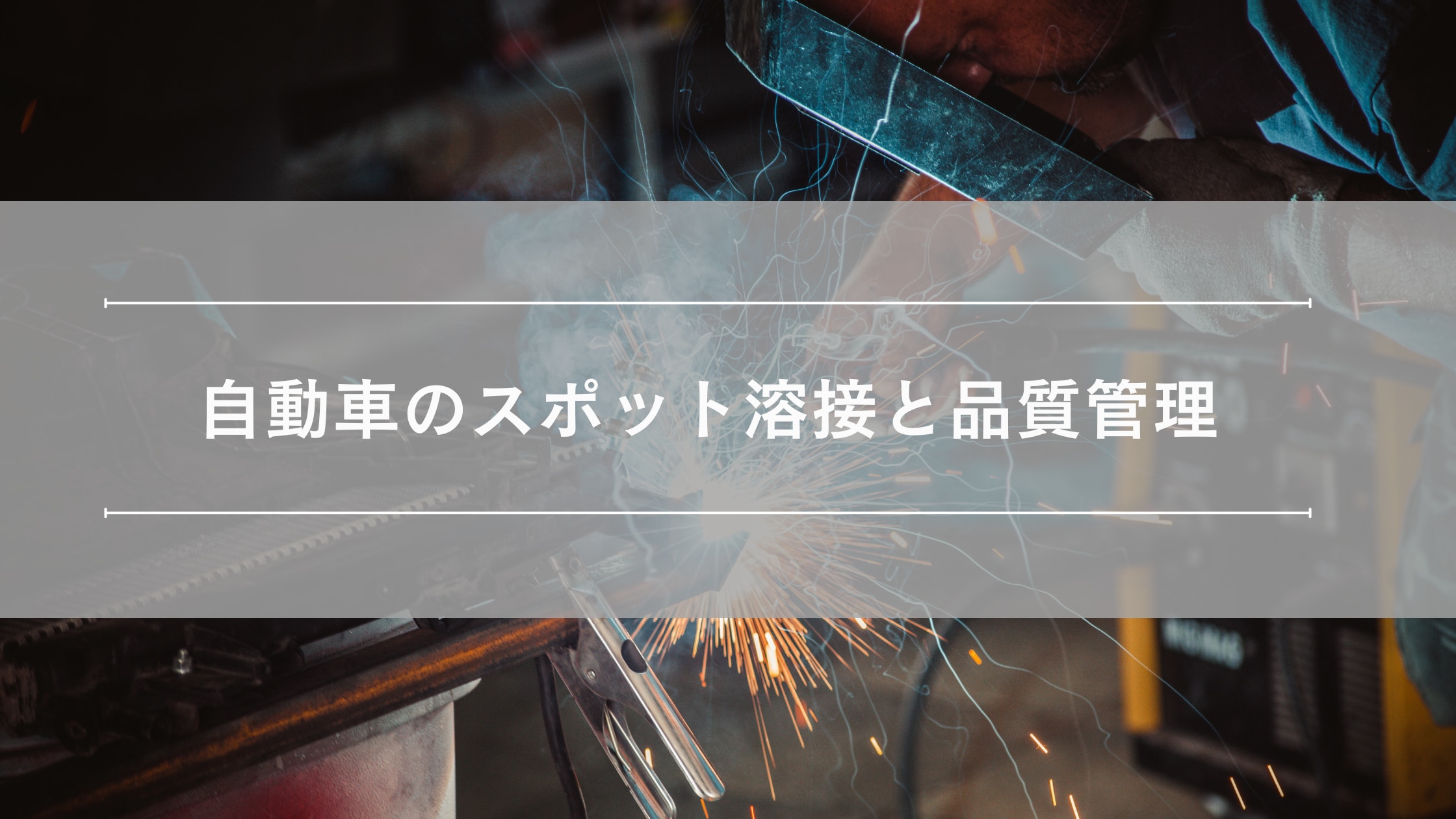
Are you doing automotive spot welding correctly? Basic procedures and quality control points
Modern automobiles have complex structures made of a variety of materials, including high-tensile steel plates, aluminum, and resin. For this reason, spot welding in automotive sheet metal repair is a task that requires high levels of skill and quality control.
In this article, we will explain the challenges of spot welding in automotive body repair, checkpoints for quality control, and key points for selecting equipment.
Table of contents [hidden]
- 1.Changes and issues in welding for automotive sheet metalworking
- 1.1.Increase in high-tensile steel and composite materials
- 1.2.Manufacturer designated and insurance covered
- 1.3.Shortening repair process lead times
- 1.4.Shortage and Variation of Welding Workers
- 2.Points to note when performing spot welding
- 2.1.Appropriate current duration, current and welding force (three major conditions)
- 2.1.1.Power-on time
- 2.1.2.Current
- 2.1.3.Pressurewelding force
- 2.2.Checking the nugget diameter and indentation
- 2.3.Precautions for each material (high tensile steel plate/aluminum body, etc.)
- 2.4.Consideration of spot placement and reinforcement structure for each part
- 3.Quality control checkpoints
- 3.1.Depthof the recess
- 3.2.Weld cracks
- 3.3.Nuggetpenetration rate
- 4.Pointsto consider when selecting a spot welding machine
- 4.1.Accuracyand stability of current control (inverter method)
- 4.2.Coolingmethod for electrode arm and secondary cable
- 4.3.Compliance with Certifications and Standards
- 5.Spot welding machine application examples
- 6.Summary_
Changes and challenges in welding for automotive sheet metal
Increase in high-strength steel and composite materials
As automobiles become lighter and stronger, the use of various metallic materials such as high-tensile steel plates and aluminum alloys is increasing, and resin-based composite materials are also being adopted in some areas.
These metal materials have different welding characteristics than conventional steel plates, making it difficult to set appropriate welding conditions and requiring advanced techniques.
Manufacturer designated and insurance covered
Automobile manufacturers specify repair methods for each vehicle model, and when it comes to spot welding in particular, the equipment to be used, welding conditions, and quality standards are strictly regulated. In addition, when it comes to insurance repairs, repairs must be carried out in accordance with the insurance company's standards.
To meet these standards, auto repair shops must stay up to date with the latest technical information and select the appropriate equipment and welding conditions.
Shortened repair process delivery time
As customer needs become more diverse, there is a demand for repair processes to be completed in shorter time frames.
Since the welding process is a crucial step in auto body repair, improving the efficiency of this work contributes greatly to shortening the overall repair time.
For this reason, various measures are required, such as introducing high-performance welding machines and reviewing work procedures.
Shortage and inconsistency in welding workers
The shortage of skilled welders is an issue for the entire automotive sheet metal industry. In addition, there is a possibility that welding skills will vary depending on the worker, so stabilizing quality is an important issue. Effective measures include thorough education and training of workers and the introduction of a system that can numerically manage welding quality.
Spot welding, also known as resistance welding or resistance spot welding, is a type of welding that uses energy from electrical resistance to join parts.
Please also read the article below for an explanation of the basics of spot welding and the differences between spot welding, arc welding, and laser welding.
▼Related articles here▼
Points to note when performing spot welding
Setting the welding conditions and checking the results after welding are important for high-quality spot welding.
Appropriate current flow time, current and welding force (three major conditions)
The quality of spot welding is largely determined by three major conditions: welding time, current, and welding force.
The optimal values for these conditions vary depending on the material, plate thickness, shape, surface condition, type of welding machine, etc. Therefore, it is necessary to always create test pieces before welding to determine the appropriate conditions.
Power-on time
This refers to the time that heat is supplied to the weld.
If the current is applied for too long, the nugget (weld) may overheat and the weld strength may decrease.
Conversely, if the current application time is too short, the nugget may be small and the weld strength may be insufficient.
current
Determine the amount of heat generated in the weld.
Too much current can result in too large a nugget or even expulsion.
Conversely, if the current is too small, the nugget will be small and the weld strength may be insufficient.
welding force
This refers to the force that presses the electrode onto the base material.
welding force is necessary to bring the base materials into close contact and allow the current to flow effectively. If welding force is too high, the nugget will be smaller and the joining strength will decrease.
Conversely, if welding force is too small, spatter may occur and the tensile strength may be compromised.
Checking nugget diameter and indentation
To check the quality of a spot weld, it is necessary to measure the nugget diameter and the depth of the impression.
The nugget diameter is directly related to the weld strength and must meet the lower limit specified by JIS standards, etc. The depth of the indentation is an indicator of the amount of deformation of the base material, and if it is too deep, the strength of the base material may decrease.
Important points to note for each material, such as high-tensile steel plate/aluminum body
High-tensile steel plates are susceptible to heat effects during welding, which can reduce their strength. Therefore, it is important to set appropriate welding conditions and minimize the heat effects.
Aluminum is a material that is prone to welding defects because heat during welding diffuses rapidly due to its high thermal conductivity. Therefore, it is necessary to use a high-power welding machine or increase the welding speed.
Consideration of spot placement and reinforcement structure for each part
Automobile bodies have parts that require strength and parts that do not. Therefore, when spot welding, it is necessary to consider the strength requirements of each part and set the appropriate spot arrangement and welding pitch.
Also, if there is a reinforcing structure, the welding must be done in such a way as not to affect that structure.
Click here for details on spot welding machines≫≫≫
Checkpoints for quality control
Quality control of spot welding is an important process that is directly linked to the safety of the final product.
The set values vary depending on the automobile manufacturer, model, vehicle part, plate thickness, and material, so it is important to check the standard values for each and perform welding that matches them.
Depth of the recess
The depth of the indentation caused by pressing the electrode is generally about 0.2 to 0.5 mm, but this varies depending on the car manufacturer and the repair manual. If it is too deep, the thickness of the base material will be thinned and its strength may decrease. Use a special gauge to measure accurately and make sure it does not exceed the standard value.
The nugget diameter guidelines based on JIS and vehicle manufacturer standards are as follows:
Steel plate thickness (t) | Minimum nugget diameter guideline (mm) |
t = 0.8 mm | Approx. 5.0 mm |
t = 1.0 mm | Approx. 6.0 mm |
t = 1.2 mm | Approx. 7.0 mm |
t = 1.6 mm | Approx. 8.0 mm |
*The actual figures will vary depending on the manufacturer and part (exterior panel/frame), so be sure to check the service manual or repair instructions.
The nugget diameter is correlated with the weld strength and must meet the lower limit specified by the JIS standard. The appropriate nugget diameter varies depending on the base material material and plate thickness, so test welding should be performed in advance to determine the optimal welding conditions and confirm the nugget diameter welded under those conditions.
Weld cracks
Cracks may occur in welded parts due to the heat effects and stress concentration during welding. Visual inspection is required to check for cracks. Cracks may cause a decrease in strength.
▼ Timing of confirmation
Immediately after welding | Presence or absence of overheat cracks and surface defects |
After cooling/forming | Check for reheat cracks and surface cracks |
Before painting | Final check before sealing. If there are any cracks, rework is required. |
As an inspection record | Photo recording and filling out inspection sheets (for insurance repairs, etc.) |
Nugget penetration rate
The nugget penetration ratio is an index that indicates the proportion of the cross section of the weld that is occupied by the nugget.
If the penetration rate is low, the weld strength may be insufficient. Conduct a cross-sectional inspection to check whether the penetration rate meets the standard value. For details on the penetration rate, please refer to the repair standard (manufacturer's instructions) for each vehicle model and part.
Points to consider when selecting a spot welding machine
In order to ensure thorough quality control, it is important to select a welding machine with appropriate functions.
Current control accuracy and stability (inverter method)
In spot welding, the balance of the three major conditions of welding time, current, welding force is important, but the accuracy of current control in particular is directly linked to quality.
Inverter welding machines can precisely control the current, enabling stable nugget formation according to the thickness and material of the base metal. Inverter welding machines are now becoming the standard in workplaces where quality control is important.
Cooling method for electrode arms and secondary cables
Since spot welding machines use high current, the electrode arm and secondary cable become very hot. Therefore, efficient heat dissipation has a major impact on quality.
In particular, the water-cooled type effectively suppresses heat and prevents the temperature of the electrode from rising, resulting in stable welding quality. The nugget diameter remains stable even during continuous work, and electrode wear is reduced, reducing the frequency of maintenance.
On the other hand, air-cooled systems are less expensive, but there is a risk of quality variations and accelerated electrode wear due to heat. In workplaces where quality is important, it is recommended to choose water-cooled systems.
Compliance with certifications and standards
It is predicted that welding conditions will become even stricter and vehicle bodies will have even greater rigidity. To meet this demand, it is important to select a model that not only meets current requirements, but also has the welding capacity to meet future standards with a margin of error.
TECN spot welding machines meet all the criteria for selection, and are equipped with the capacity and rigidity to handle the increasingly stringent welding conditions of automotive maintenance.
For more product informationDownload the catalogue herePlease check.
Spot welding machine introduction examples
Here we will introduce some examples of companies that have improved quality and work efficiency by introducing spot welding machines.
Toyo Body Co., Ltd.
Toyo Body Co., Ltd. has obtained the "TUV Platinum Certification," the highest rank in the certification standards for body repair and painting factories. With the latest equipment, including spot welding machines, they are in an environment that allows them to constantly keep up with advances in car bodies, materials, and welding conditions, so they can confidently provide customers with peace of mind and safety.
▼Check out the examples▼
Kaneko Motors Co., Ltd.
Kaneko Motors Co., Ltd.'s body repair and painting services have a good reputation among its competitors, and their careful work is highly rated. As a result, they have been selected as a subcontracting factory for the luxury foreign car dealership "YANASE". Furthermore, they offer a "One Owner Lifetime Repair Guarantee" and have a system in place to provide support for repaired parts until the very end, providing peace of mind to customers.
▼Check out the examples▼
For those looking for a spot welding machine
summary
High-quality spot welding leads to gaining trust from customers, which in turn contributes to improving the company's brand image. By introducing a high-performance welding machine, you can expect to improve welding quality and work efficiency. When choosing a welding machine, be sure to carefully consider the quality control functions.








